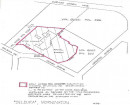WOMEN'S SUFFRAGE PETITION
PUBLIC RECORDS OFFICE VICTORIA, 99 SHIEL STREET NORTH MELBOURNE, MELBOURNE CITY
-
Add to tour
You must log in to do that.
-
Share
-
Shortlist place
You must log in to do that.
- Download report


Statement of Significance
What is significant?
The Women's Suffrage Petition 1891, held by the Public Record Office Victoria, requesting the right to vote for women in the colony, was signed by 30,000 Victorian women. It was presented to the Victorian Parliament with the support of Premier James Munro, by the Women's Christian Temperance Union and the Victorian Temperance Alliance. In 1891 members from the Woman's Christian Temperance Union and the Victorian Temperance Alliance together with other women's suffrage groups collected signatures from women throughout Victoria requesting the right to vote for women in the colony. The petition stated 'that government of the People, by the People and for the People should mean all the People, not half'. It was also noted 'that all Adult Persons should have a voice in Making the Laws which they are required to obey'. The Women's Suffrage Petition 1891 was known as the 'Monster Petition' because it was the largest petition that had ever been presented to the Parliament of Victoria on any question.
The first women's suffrage society had been founded in 1884 by three Victorian women, Henrietta Dugdale, Annie Lowe and Vida Goldstein. The Women's Christian Temperance Union, established in Melbourne from the United States in 1887, was an influential organisation run for and by women and was involved in many social reform campaigns, as well as temperance, including, most notably, the vote for women. The temperance organisations realised that if women had the vote they could influence social policy and legislation.
The petition of 1891 demonstrated that women were becoming politically active and could no longer be ignored as a political force. In the 1890s, women's suffrage Bills came regularly before Parliament but were blocked by the Legislative Council and it was not until 1908 that Victorian women were able to vote in state elections. Victoria's decision to grant women votes was preceded by New Zealand (1893), South Australia (1894) and Western Australia (1899) while the Federal Parliament passed the Commonwealth Franchise Act of 1902 enabling Australian women to vote at a federal level, as they did in the first federally organized election in 1903. Australia became the second country in the world to give women adult suffrage.
The original Women's Suffrage Petition 1891 listing nearly 30,000 signatures, is approximately 260 metres long and 200mm wide and is made of paper pasted to cotton or linen fabric backing, rolled onto a cardboard spindle which rests on a Perspex stand. The signatures and other details on the petition have been digitally transcribed and developed into a searchable database. They are available on both the Parliament of Victoria and Public Record Office Victoria websites.
How is it significant?
The Women's Suffrage Petition 1891 is of historical and social significance to the State of Victoria.
Why is it Significant?
The Women's Suffrage Petition 1891 is of historical significance in the history of the women's suffrage movement in Victoria.
Women's Suffrage Petition 1891 is of historical significance for its associations with the history of women's organizations in Victoria. It demonstrates the cooperation of the various women's organisations in their determination to gain women's rights.
The Women's Suffrage Petition 1891 is of historical significance as a rare historical record of nearly 30,000 Victorian women's commitment to their rights, in that women's political views were seldom recorded.
-
-
WOMEN'S SUFFRAGE PETITION - History
History
(supplied by the nominator, PROV)
Without the votes that would enable them to directly influence legislation, Victorian women resorted to the use of petitions to plead for the support of members of Parliament for universal suffrage.
In 1891 members from the Woman's Christian Temperance Union and the Victorian Temperance Alliance together with other women's suffrage groups collected signatures from women throughout Victoria requesting the right to vote for women in the colony. The petition stated 'that government of the People, by the People and for the People should mean all the People, not half'. It was also noted 'that all Adult Persons should have a voice in Making the Laws which they are required to obey'.
It reflects the dedicated work of many women, who went from door to door collecting signatures from women over 21 years of age living in the country towns as well as the city suburbs. Nearly 30,000 signatures were recorded on sheets of paper which were then glued together forming a giant petition presented to the Parliament. The signatures were collected in six weeks. The 'Monster Petition' took several attendants to carry it into the Legislative Chamber as it was so bulky
There were a number of other Women's suffrage petitions presented to the Parliament but they were not as large as the 1891 'Monster Petition'.
A woman's right to vote in state elections was a different matter, and varied from state to state. Victorian women won the right to vote in 1908.
In 1894 the Women's Progressive Leagues, the Women's Social And Political Reform League and the Victorian Women's Suffrage League, the Victorian Lady Teachers' Association, Trades Hall Council, the Central Methodist Association, the Prahran Women's Franchise League, etc were some of the many women's organisations that supported women's suffrage.
In 1884 suffragists Henrietta Dugdale and Annette Bear Crawford formed the Victorian Women's Suffrage Society, the first such organisation in the Australian colonies.
Annette Bear Crawford formed the United Council for Women's Suffrage (UCWS) in 1894 to coordinate the efforts of these suffrage societies. In 1900 there were thirty-two societies affiliated with the UCWS. Vida Goldstein became the suffrage movement's first full-time paid organiser in 1900.
Members of these women's suffrage organisations were called suffragists. 'Suffragists' were women (and men) who advocated suffrage for women and were generally conventional in their forms of agitation. There were no suffragettes in the Australian campaigns. 'Suffragette' was a label first given to British women who had become disillusioned with the normal channels of agitation and were moving to violent forms of protest such as the destruction of property and hunger strikes in jail.
Petitions in support of women's suffrage were also collected in other states and presented to the various parliaments.
It is the largest petition tabled to Parliament in the nineteenth century. The Petition has been transcribed and placed online on the Parliament of Victoria and on Public Record Office Victoria websites. The recent transcription of the details of the women who signed the petition has facilitated for the first time access and historical research on women on the data base.
Often 'ordinary' women's voices are left out of historical accounts and the petition provides a historical record of nearly 30,000 Victorian women's commitment to their rights.
The Victorian Parliament finally granted women in the state suffrage in 1908 largely because of the pressure exerted by the meteoric rise of the conservative women's group, the Australian Women's National League that convinced the Conservatives in parliament that women's votes would not be radical (in 1908 the AWNL had approximately 10,000 members in Victoria). Continuous pressure from the apolitical National Council of Women of Victoria and from Sir Thomas Bent's largely factional coalition to acknowledge that the rest of Australia had state suffrage: the fear that the Victorian 'good fighters' might metamorphose overnight into dreaded suffragettes and bring condemnation on Victoria and the rest of Australia.
The WCTU and VTA were important grass-roots movements with international connections.
The Melbourne Branch of the Women's Christian Temperance Union (WCTU) was founded in 1887. The model was directly inspired by the WCTU that had been founded in the northern States of America in 1874. The American Branch sent out 'world missionaries' to help found branches in other countries. Mary Clement Leavitt visited Australia and New Zealand in 1885 and inspired the creation of a number of branches throughout the Australian colonies, in both rural and city areas, but the largest branch was in the Colony of Victoria. The WCTU was an influential organisation run for and by women and was involved in many social reform campaigns, as well as temperance, including, most notably, the vote for women. The WCTU realised that if women had the vote they could influence social policy and legislation. Meanwhile the Union was active campaigners with petitions, letter writings, education programs and meetings.
WOMEN'S SUFFRAGE PETITION - Permit Exemptions
General Exemptions:General exemptions apply to all places and objects included in the Victorian Heritage Register (VHR). General exemptions have been designed to allow everyday activities, maintenance and changes to your property, which don’t harm its cultural heritage significance, to proceed without the need to obtain approvals under the Heritage Act 2017.Places of worship: In some circumstances, you can alter a place of worship to accommodate religious practices without a permit, but you must notify the Executive Director of Heritage Victoria before you start the works or activities at least 20 business days before the works or activities are to commence.Subdivision/consolidation: Permit exemptions exist for some subdivisions and consolidations. If the subdivision or consolidation is in accordance with a planning permit granted under Part 4 of the Planning and Environment Act 1987 and the application for the planning permit was referred to the Executive Director of Heritage Victoria as a determining referral authority, a permit is not required.Specific exemptions may also apply to your registered place or object. If applicable, these are listed below. Specific exemptions are tailored to the conservation and management needs of an individual registered place or object and set out works and activities that are exempt from the requirements of a permit. Specific exemptions prevail if they conflict with general exemptions. Find out more about heritage permit exemptions here.Specific Exemptions:General Conditions: 1. All exempted alterations are to be planned and carried out in a manner which prevents damage to the fabric of the registered place or object. General Conditions: 2. Should it become apparent during further inspection or the carrying out of works that original or previously hidden or inaccessible details of the place or object are revealed which relate to the significance of the place or object, then the exemption covering such works shall cease and Heritage Victoria shall be notified as soon as possible. Note: All archaeological places have the potential to contain significant sub-surface artefacts and other remains. In most cases it will be necessary to obtain approval from the Executive Director, Heritage Victoria before the undertaking any works that have a significant sub-surface component. General Conditions: 3. If there is a conservation policy and plan endorsed by the Executive Director, all works shall be in accordance with it. Note: The existence of a Conservation Management Plan or a Heritage Action Plan endorsed by the Executive Director, Heritage Victoria provides guidance for the management of the heritage values associated with the site. It may not be necessary to obtain a heritage permit for certain works specified in the management plan. General Conditions: 4. Nothing in this determination prevents the Executive Director from amending or rescinding all or any of the permit exemptions. General Conditions: 5. Nothing in this determination exempts owners or their agents from the responsibility to seek relevant planning or building permits from the responsible authorities where applicable. Minor Works : Note: Any Minor Works that in the opinion of the Executive Director will not adversely affect the heritage significance of the place may be exempt from the permit requirements of the Heritage Act. A person proposing to undertake minor works may submit a proposal to the Executive Director. If the Executive Director is satisfied that the proposed works will not adversely affect the heritage values of the site, the applicant may be exempted from the requirement to obtain a heritage permit. If an applicant is uncertain whether a heritage permit is required, it is recommended that the permits co-ordinator be contacted.STANDARD EXEMPTION :CONSERVATION
The conservation, research or analysis of a registered heritage object does not require approval by the Executive Director pursuant to the Heritage Act 1995, where the activity is performed in accordance with the accepted standards, policies and procedures of the Public Records Office Victoria.
STANDARD EXEMPTION : MOVEMENT OR RELOCATION
The temporary relocation, movement or external loan of a registered heritage object does not require permit approval by the Executive Director pursuant to the Heritage Act 1995 where the activity is performed in accordance with the accepted standards, policies and procedures of the Public Records Office Victoria. .
WOMEN'S SUFFRAGE PETITION - Permit Exemption Policy
The object should be housed and conserved so as to maintain its cultural heritage significance. Exemptions will usually be granted for movement, relocation, loan and conservation activities, as specified below.
The original material is stored in a secure repository and appropriate climatic conditions.
The signatures and other details on the petition have been digitally transcribed and developed into a searchable database. They are available on both the Parliament of Victoria and Public Record Office Victoria websites.
Requests for access to records of the Parliament of Victoria must be referred to the Clerk of the Legislative Council or the Clerk of the Legislative Assembly as required. Written approval must be presented to PROV before the records will be made available for public inspection. However the Women's Suffrage Petition 1891 is extremely fragile and cannot be unrolled for inspection of individual names.
-
-
-
-
-
BRASSEY HOUSE
 Victorian Heritage Register H0026
Victorian Heritage Register H0026 -
FORMER PRESBYTERIAN UNION MEMORIAL CHURCH COMPLEX
 Victorian Heritage Register H0007
Victorian Heritage Register H0007 -
RESIDENCE
 Victorian Heritage Register H0091
Victorian Heritage Register H0091
-
"1890"
 Yarra City
Yarra City -
'BRAESIDE'
 Boroondara City
Boroondara City -
'ELAINE'
 Boroondara City
Boroondara City
-
-
Notes See all notes
17/11/14
Brilliant app! Any chance of linking through to http://amw.org.au/content/australian-register
Public contributions
Notes See all notes
17/11/14
Brilliant app! Any chance of linking through to http://amw.org.au/content/australian-register












